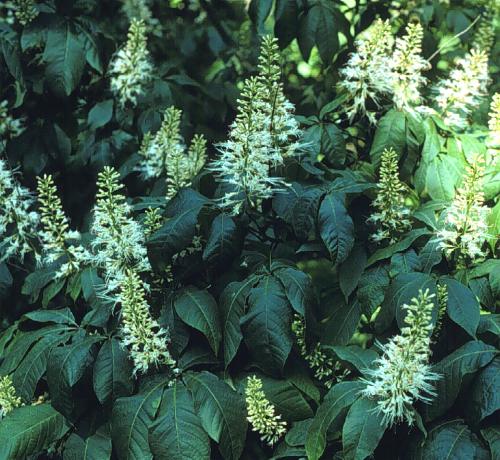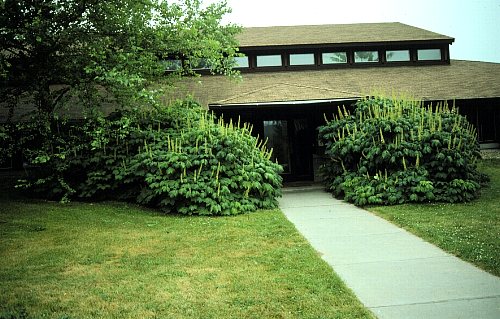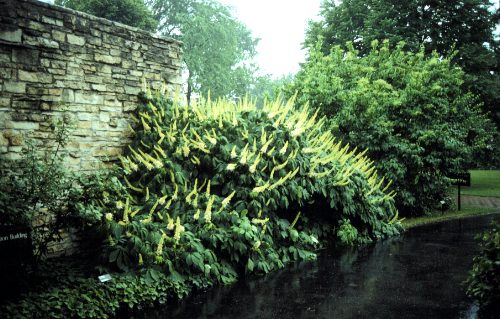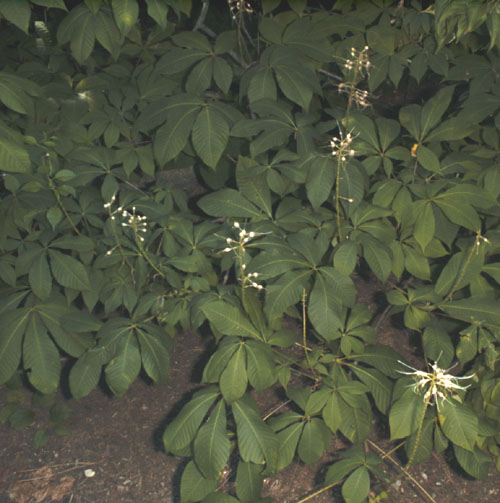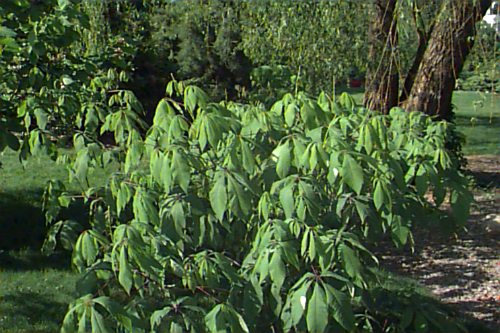Aesculus parviflora
Bottlebrush Buckeye
Hippocastanaceae
ExpandHabitat
- southeastern United States
- zone 5 (possibly 4)
Habit and Form
- 8' to 12' tall and 8' to 15' in spread
- a deciduous, suckering, multi-stemmed shrub
- medium to coarse texture
- upright, irregular and spreading branching
- somewhat similar to sumac, Rhus typhina, in growth habit
Summer Foliage
- opposite, palmately-compound leaves, with 5 to 7 leaflets
- leaflets 3" to 8" long, 1.25" to 4" wide
- color typically a dark or medium green on top and grayish and pubescent
underneath
Autumn Foliage
- can be a good, clear yellow, but frequently is yellow-green
Flowers
- blooms in mid-July, with showy white flowers
- 8" to 12" long panicles
Fruit
- a 1" to 3" long, pear-shaped dehiscent capsule
- smooth husks are light brown with nuts inside
- in the northeastern United States, fruit set is rare due to an insufficiently long growing season
Bark
- smooth, gray and somewhat showy
Culture
- best in full sun, but quite tolerant of partial shade
- transplant B&B or from a container
- prefers a moist, well-drained soil high in organic matter with slightly acid pH
- can be rejuvenated by heavy pruning
Landscape Use
- needs a large space because of its spreading tendency
- good as a specimen; uncommon
- in a border or for massing
- erosion control, soil stabilization
- beneath the high canopy of scattered, large shade trees
- for decoration (flowers)
Liabilities
- not as prone to Aesculus diseases and insect problems as other species
- relatively maintenance free
- can be hard to locate in the trade
- can be somewhat invasive if given too small of a landscape space
ID Features
- suckering habit
- palmately-compound leaves
- smooth fruit husks
- buds are whitish
- many terminals lack a terminal bud that is replaced by a long, persistent fruit pedicel or its scar
- bundle scars usually 3
- stems are gray
Propagation
- by seed, but seed set will be low or fail to develop fully in short growing season locations
- root cuttings
Cultivars/Varieties
var. serotina - An interesting natural form from Alabama with the habit of flowering up to 3 weeks later than the species. A great shrub for color in summer, often growing larger than the species (to 20' tall). Offered increasingly by specialty nurseries.
'Rogers' - A selection of A. p. var. serotina with very large inflorescences (to 30" long), later bloom and larger size (to 20'). Offered by some specialty nurseries and a worthy addition to the large landscape.
